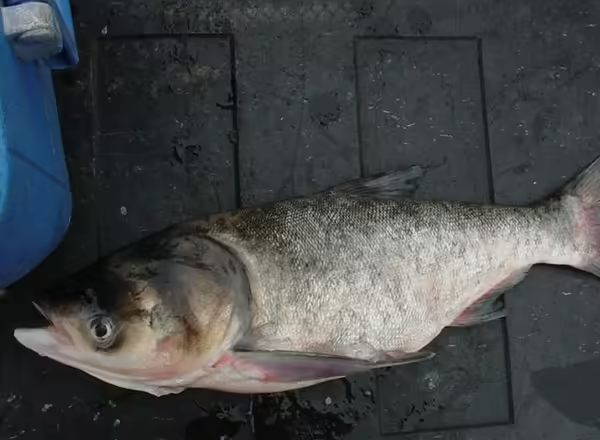
Bighead and Silver Carp
“Asian carp” is the collective term that refers to bighead carp, silver carp, black carp, and grass carp. Bighead and silver carp are non-native fish invading lakes and rivers in the Mississippi River and Great Lakes regions, and negatively impacting native organisms. These fish are voracious eaters and filter tremendous amounts of small plants and plankton from the water, reducing the amount of food available to native species. Impact and distribution vary among the four species.
Asian carp were originally brought into the U.S. for aquaculture in the 1960s and 1970s, but through flooding, legal releases, and illegal releases, they have become established in the Mississippi and Illinois rivers and beyond. They have not been found in Lake Michigan as of 2023.
- Bighead carp (Hypophthalmichthys nobilis) are native to southern and central China and were initially introduced to the United States for aquaculture and phytoplankton control in 1973. Bighead carp are also known as noble fish, speckled amur, or lake fish.
- Silver carp (Hypophthalmichthys molitrix) are native to several major Pacific Ocean drainages in eastern Asia. Silver carp were introduced to the U.S. in 1973 when they were intentionally imported for aquaculture, phytoplankton control, and human consumption. Silver carp are known colloquially as “flying fish,” as they have been known to leap out of the water when startled by loud noises such as a boat motor.
- Black carp (Mylopharyngodon piceus) also known as snail carp, black amur, and black Chinese roach are native to most major Pacific Ocean drainages of eastern Asia. The species was introduced to the U.S. in the early 1970s and 1980s as a means for biological control and human consumption. Black carp were used to control snails and other mollusks and yellow grub in lakes and ponds. Like many of the invasive Asian carp species, flooding of aquaculture facilities has led to their escape into large river systems.
- Grass carp (Ctenopharyngodon idella) are also known as white amur. This species is native to eastern Asia. They were originally introduced to the U.S. in the 1960s for aquaculture. Grass carp were imported as a form of biological control to manage aquatic weed and phytoplankton problems in lakes and ponds, and stocking of grass carp to manage nuisance aquatic plants continues today. Many factors have contributed to their spread in the U.S. including stocking by federal, state, and local government agencies; legal and illegal interstate transport via release by individuals and groups; and escape from ponds and aquaculture facilities.

- Bighead carp can reach up to 5 feet in length and weigh up to 90 pounds. They are deep-bodied, compressed fish, meaning they have very flat sides that allow them to swim quickly through the water. They exhibit a dark gray coloration on their backs that fades to white towards their belly. Bighead carp earn their name from their sizable scaleless head with a large mouth and protruding lower jaw with no teeth.
- Silver carp are generally smaller than bighead carp (Hypophthalmichthys nobilis) but still typically weigh around 60 pounds and can exceed 3 feet in length.
- Black carp have an elongated, narrow body with a blunt head and a slightly down-turned mouth. Their coloration is brown to black on their back that fades to a gold sheen on their belly. Their large teeth help them crush the shells of the mollusks they consume. Black carp can reach over 5 feet long and weigh up to 150 pounds.
- Grass carp can grow over 5 feet long and weigh more than 80 pounds. Grass carp have large, circular scales with a black spot at the base. Grass carp’s throat teeth look slender like teeth of a comb. In fact, the genus name Ctenopharyngodon means “comb-like” in Greek.
A variety of steps can be taken to monitor, control, and manage Asian carp early which population densities are still relatively low. Mechanical removal through fishing can have a significant impact on slowing population expansion and establishment. An electric dispersal barrier separates Lake Michigan from the Illinois River as a preventative measure to keep Asian carp from moving into the Great Lakes.
Asian carp are edible, and the state of Illinois has encouraged a supply chain to fish Asian carp for public sale and consumption through its choose copi initiative.
- REMOVE plants, animals, and mud from all equipment. Mud and plant fragments can also hide aquatic invasive species that are too small to be seen with the naked eye.
- DRAIN all water from your boat and gear. Boaters should ensure plugs are pulled from bilge and live wells before leaving a waterway. Bait bucket water should be drained on land.
- DRY everything thoroughly with a towel. All equipment that comes into contact with water should be wiped off and dried with quick-dry towel. If possible, dry everything for five days before entering new waters.
Clean other equipment as necessary. Waders and boots should be scrubbed and rinsed with tap or well water. If possible, use hot or high-pressure water to clean your equipment. Using a car wash for your boat and trailer is a great alternative. Full-strength white vinegar or a solution of ¼ cup bleach per gallon of water can be used to disinfect equipment and confined spaces like live wells.
- Prairie Research Institute, Illinois Natural History Survey, Asian Carp in the Upper Mississippi River
- Prairie Research Institute, Illinois Natural History Survey, From the field
- Choose Copi